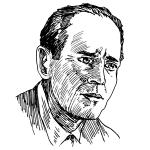In 1957, Alfred Hitchcock cast James Stewart as the lead in Vertigo. You know the story: Scottie Ferguson, an acrophobic detective, falls in love with the woman he’s hired to shadow—the mysterious Madeleine. In thrall to melancholy, she leaps from a bell tower to her death; Scottie, catatonic with guilt, is institutionalized. Months later he spots Judy, a woman who resembles Madeleine; exploiting her neediness, he makes her over in the image of the dead woman—then learns Judy was Madeleine: she’d impersonated her in a (most implausible) murder plot. Enraged, Scottie constructs a climax that allows him to negate his guilt with a cruel act of revenge.
Vertigo’s sensibility was complex, its matter murky—and the casting of its protagonist one of the great mistakes in movie history. James Stewart, an amiable actor of limited resources, was the wrong man to play Scottie. The right man, the only man, would have been Henry Fonda.
It could so easily have happened that way. Fonda had starred in Hitchcock’s previous movie, The Wrong Man (1956), a fact-based chronicle of false arrest. Its coscenarist, Maxwell Anderson, was enlisted to draft the first Vertigo script, from the Boileau-Narcejac novel D’Entre les morts (literally, “From among the Dead”). Initially cast in the dual role of Madeleine/Judy was Vera Miles, Fonda’s costar in The Wrong Man. (Sidelined by pregnancy, she would be replaced by Kim Novak.) Vertigo’s other female lead, Scottie’s gal pal Midge, was played by Barbara Bel Geddes—Fonda’s costar, one year later, in Silent Night, Lonely Night on Broadway.
Coincidences. Show business, we hear, is a small world: these are only the happenstantial hellos of professionals crossing the same stages and studios.
But there are deeper reasons for projecting Fonda onto Vertigo’s scenario of romantic loss and morbid fixation. In 1950, his second wife, the socialite Frances Seymour, who had been in and out of institutions for years, cut her throat in an upstate New York asylum, with a smuggled razor, on her forty-second birthday. On New Year’s Day, 1960, Fonda’s first wife, the actress Margaret Sullavan—like Frances, a probable manic depressive (and erstwhile James Stewart costar)—would be found in a New Haven hotel room, having overdosed on pills. In those years, Fonda was investigating suicide, depression, and alienation in his stage, screen, and television roles (The Petrified Forest, Two for the Seesaw, A Gift of Time). He was speaking from among the dead.
“My life has been peppered with suicides,” Fonda said not long before he died, “and I don’t like to think back on them.”
We...
You have reached your article limit
Sign up for a digital subscription and continue reading all new issues, plus our entire archives, for just $1.50/month.
Already a subscriber? Sign in





